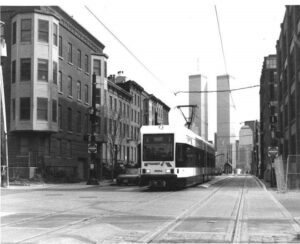Good Golly Missed Trolley! (updated Spring, 2024)
UPDATED GOOD GOLLY TROLLEY Spreadsheet (updated SPRING, 2024)
The first forms of public transportation were horse car lines. One hundred fifty years before the NYC subways were built, most of those horse car lines in the outer boroughs terminated at the various ferry lines that would eventually bring their riders into Manhattan. Running at a 4-cent fare, each car was usually pulled by four horses that were decorated with rows of bells to warn pedestrians, similar to what one would see today on Main Street USA at Disneyland or Disneyworld. A horse stable was usually built at the end of the line.
With the disadvantages and limitations of horse cars obvious, cable car lines started to appear. Electric cars were the next progression and by 1895, almost all of the horse car routes had been converted. Those same horse stables were now renamed car barns.
By 1905, convertible trolley cars started appearing. These cars had side panels that were removed in summertime, thus doing away with the necessity of maintaining two fleets of cars, one with closed bodies for winter service and the other with open benches for summer service.

These center door trolleys had no front door and required a two-man operation, one set of controls in the front and another in the rear.
By 1919, there was a fleet of lightweight double end cars designed by Charles O. Birney and were the first cars of this popular design to be built by the J.G. Brill Company. The idea was that passengers boarded at the center door and exited at the front, paying their fare as they passed the conductor stationed just forward of the center door.

The concept was to operate two cars with the same two men assigned to the bigger single trolley and instead run two small cars without using more electricity that would be needed for the larger car. By doubling the service, the thought would be that there would always be another car in sight. Thus the saying “men/women are like buses (trolleys), another one comes along every few minutes.”
The Depression forced the conversion to a one-man operation. To make this alteration more seamless, track loops were used rather than have the motorman move to the opposite end of the coach.
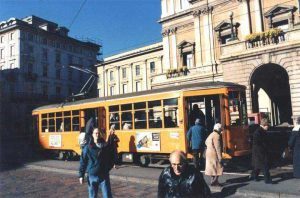
The first Lionel issue #60 Lionelville Trolley came in five different versions, all were yellow and variations had black, blue or red lettering, with and without roof vents, and the earliest production run had disappearing motormen at each end, whose appearance would be determined by the direction the car was traveling.
| VARIATION | LETTERING | MOTORMAN | BUMPER | CLERESTORY | NOTE |
| VENTS | |||||
| A | BLACK | YES | 2 PIECE | NO | 1955 PRODUCTION |
| B | BLACK | NO | 2 PIECE | NO | |
| C | BLUE | NO | 2 PIECE | NO | COMMON |
| D | BLUE | NO | 1 PIECE | NO | |
| E | BLUE | NO | 1 PIECE | YES | 1956 PRODUCTION |
| F | RED | NO | 2 PIECE | NO | EXTREMELY RARE |
| G | GREEN | NO | 2 PIECE | NO | NOT PREVIOUSLY DOCUMENTED |

VERSION “A”
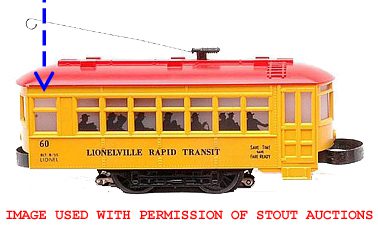
VERSION “B”
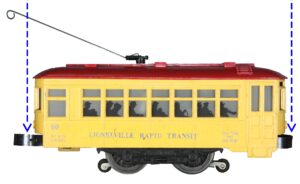
VERSION “C”

VERSION “D”
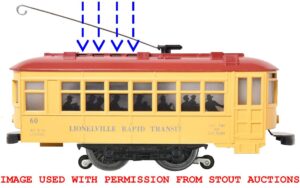
VERSION “E”

VERSION “F”

VERSION “G”
Later versions included and excluded the poles and rubber bumpers. Most were part of no longer offered Christmas sets that included the trolley, track, bumpers and power track. Dealers are not happy about this decision though, because it had made a relatively inexpensive and ready to run mini-starter set.
The Lionel version of the Brill trolley has included variations with and without the poles and rubber bumpers.
Although a slightly different design from the Lionel version of the Brill trolley and more prototypical, 2nd Runner Up prize for best Lionel wannabe trolley in typical Lionel color scheme goes to Industrial Rail #14003. Seen at the former Green Hall at York for only $45, a nice alternative:

MISCELLANY:

While roaming the aisles of the Silver Hall at the October 2001 York, I noticed an unfamiliar looking box. (How does one notice something that is unfamiliar???)
Having collected all of the Postwar and Modern Lionel motorized units, I was perplexed what I was staring at. I was not sure that it was even an authentic Lionel product.
So, I contacted my buddy and Lionel Modern Era expert extraordinaire, Dennis Leon Clad, and asked if he knew of this item.
It turns out that it is definitely an uncatalogued Lionel issue, #6-11850 “Rice A Roni
Trolley Set.”
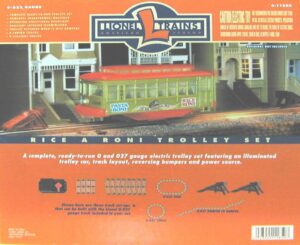
Quaker Oats employees and retirees had placed their orders for this unique item in the Spring of 2001 with delivery in the fall of 2001, obviously before October York. At that time, the set was going for about $125, but now commands something in the $300 range.
As with similar trolley sets, this one comes with track, transformer and bumpers.
This set, like other Quaker Oats collectibles, was not sold to the general public and none were available for direct purchase by either Quaker Oats or Lionel.
According to Dennis, only 736 of these sets were made, making this a truly unique variation.
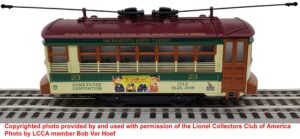
PER Dennis DeVito:
The 2009 on site car started life as the 28241 Fort Collins trolley. This car was sent to Weaver, disassembled and reworked. The line on top of the windows was changed from ‘Fort Collins Municipal Railway’ to ‘Sacramento Rapid Transit’. The area below the windows was over stamped with convention info and on site car number. The Tolley number ’23’ remained. Of note, the figure holding the gold nugget was modified from the original Sacramento logo to the convention logo by changing the gold nugget and adding a locomotive.

The Director/Officer car had the same deco work on the car body, but as noted, the roof color was changed. The following was printed on a dark brown roof ‘Officer – Director – Appointed Official – Lionel Collectors Club of America’. Although this printing was in gold on the dark brown top – it is hard to read in the box and given the slope and corner of the roofline the top line and the roof line are really hard to read. Both cars were distributed in the original 28421 box with the usual Weaver note of redeco. Understanding each of us views beauty differently, I can clearly say the O/D car of 2009 with the dark roof is a MUCH better looking car than either the original and quite bare Ft. Collins or the redeco Sacramento car with the lighter roof.
RE: volume, not sure but historically about 250 of the on-site cars were made and about 18-20 of the O/D cars.

THE ‘LAUREL LINE’ TROLLEY By Joseph A. Grzyboski III TCA 98-46957
Lionel Trains produced item #58275 the Laurel Lines Trolley exclusively for Grzyboski’s Train Store to commentate their 40th anniversary in 2017. The trolley was chosen as it is unique to the lower Lackawanna Valley and ran the rails adjacent to our store location in Moosic, Pennsylvania. The late Joseph A. Grzyboski Jr. developed the idea with a local historian, customer and friend, Leo Czereck. A volunteer with the Steamtown National Historic Site, Leo’s vast knowledge of rail history throughout the area helped the idea come to fruition. Joe & Leo spent countless time researching archives and were able to accurately depict the detail (color and lettering) as the real trolley appeared.
The Laurel Lines Trolley was part of the Lackawanna & Wyoming Valley Railroad which ran from downtown Scranton to Wilkes-Barre, PA. Sections of track are used by the Electric City Trolley Museum today.
HISTORY OF THE ‘LAUREL LINE’ TROLLEY
The Lackawanna & Wyoming Valley Railroad, more commonly known as the Laurel Line, was a Pennsylvania third rail electric interurban streetcar line which operated commuter train service from 1903 to 1952, and freight service until 1976.
| Reporting mark | LWV |
| Locale | Northeastern Pennsylvania |
| Dates of operation | 1903–1976 |
| Track gauge | 4 ft 8 1⁄2 in (1,435 mm) standard gauge |
| Headquarters | Scranton, Pennsylvania |
The line was originally owned and built by Westinghouse, Church, Kerr & Company, a subsidiary of The Westinghouse Electric & Manufacturing Company. Electrification was decommissioned in 1953, as diesel operations began. It was purchased by the Delaware, Lackawanna & Western Railroad in 1957, but operated as an independent subsidiary under it and the Erie Lackawanna until its inclusion in Conrail in 1976.
Sections of the line operate today for both freight and tourists under local county ownership, with talk of future commuter expansion.
The railroad’s main line ran from Scranton to Wilkes-Barre. Other cities served included Dunmore and Pittston.
At its peak, the line carried as many as 4.2 million passengers a year, but following World War II use declined dramatically.
Original sections of the line out of Scranton to Montage Mountain, Moosic, have been purchased by Lackawanna County, Pennsylvania, and placed back in service with overhead electrified wiring and designated-operator Delaware-Lackawanna Railroad overseeing both freight operations and the county’s tourist trolley runs, the Electric City Trolley Museum.
The Laurel Line Tunnel (also known as the Crown Avenue Tunnel) in South Scranton, constructed in 1904, remains one of the longest interurban streetcar tunnels ever built, at 4,750-feet.
Below is the link address of more information on the Laurel Line.
https://en.wikipedia.org/wiki/Lackawanna_and_Wyoming_Valley_Railroad
TCA Southern Division 50th Anniversary Souvenir Trolleys
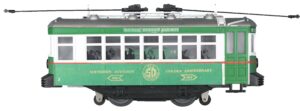
By Bill Trappen, TCA 74-6898
The TCA Southern Division Produced 50 Souvenir Trolleys for its 50th or Golden Anniversary in 2006. This article discusses the completed trolleys with photos and background information.
The TCA Southern Division 50th Anniversary Trolley is the very first Motorized Southern Division Souvenir train item. Using excess Lionel 2015 TCA Convention Coney Island trolleys purchased from the TCA, the SD 50th Anniversary trolleys were redecorated by Harry Hieke, a TCA member in New Jersey who has been designing and redecorating model trains since 1985. Harry was highly recommended by several satisfied customers (including Lionel LLC). Redecoration was completed by Harry, using decals purchased from Dandy Decals, a decal supplier in Michigan, and the trolleys were delivered to Florida during the summer of 2016. The trolleys were distributed at the TCA SD Train Meet in Venice, Florida on September 10, 2016 to members who ordered trolleys to be picked up at the Meet and shipped the following week to members who ordered trolleys to be delivered to their homes.
A total of 50 trolleys were produced with 48 “regular-production” cars plus 2 very special cars. No two cars are identical as each car has a unique trolley car or “road” number.
“Regular-production” TCA SD 50th Anniversary Souvenir Trolley
Shown on these pages is a photo of one of the “regular-production” 50th Anniversary trolley cars. The side view shows the car in traditional SD colors of Green and White with Gold lettering. All of the graphics and lettering are metallic gold. As the old saying goes these photos do not do justice to the car’s very attractive actual appearance particularly the brightness and clarity of the metallic gold lettering. I’m sure that members who bought a car will agree that the cars look much better in person.
Included on each side of the car is the SD logo along with special Golden Anniversary text plus two block arrows with one containing the founding year of the Division (1996) and the other arrow containing the year of the 50th anniversary (2016). The unique trolley car number is in the far lower left corner. Each trolley is individually numbered (the car in the photos is car #4). So each of the 50 trolley cars is indeed unique with a different car number!
The front and back of the trolley also include the block arrows and the trolley car number but in addition have lettering with the phrase “Serving the South … for Fifty Years” spread across both sides of the headlight above the red belt line as shown in the attached front view. We thank “Jake” Jacob, the original SD webmaster, for coining that phrase which was certainly very appropriate for the 50th year of the SD!
At first glance the front and back of the trolley may look identical but there is one slight difference. The 50th anniversary committee consisting of members Richard Tashjian, Mike Mills and Bill Trappen, felt that two different destinations would be more realistic for a double-end trolley than having the same destination sign in both ends as Lionel had used on the Coney Island trolleys. Plus we wanted to use destinations that would be typical of many cities in Florida. So we chose “Main St” and “Florida Ave” so that you can visualize this trolley traveling the streets of your own town back in the day! And those signs are lighted from the back using the trolley’s interior LED’s.
The committee also designed and produced special labels for the car’s original Lionel box and shipping box which were needed to cover the original Coney Island labels. Each car also includes a numbered Certificate of Authenticity signed by then SD President Brad Woodward and the members of the 50th Anniversary Committee. The number on each certificate matches the trolley car number. The regular production cars are numbered 1 through 39 and 41 through 49. There is no number 40.
The remainder of this article discusses the two “exception-al” cars.

Special GOLD SD TCA 50th Anniversary Souvenir Trolley
When the trolley project was introduced it was announced that one of the trolleys would be extra special in commemorating the Division’s 50th, or GOLDEN anniversary. Accordingly, that trolley is trolley car #50 and it is painted GOLD! How appropriate is that?
Shown below is a photo of this special Gold trolley. Note that the entire car body is painted a glossy gold including the area around the windows, the bumpers and the roof. In addition the trolley poles and its supports are gold. The lettering and the rest of its graphics are green. This trolley car is otherwise identical and has all of the same features as the regular green production trolleys as described above. It comes in a Lionel box with end labels designed specifically for this car and a Lionel shipping carton with special labels which are also pictured above. Even though each of the 50 Anniversary Trolleys is unique by being individually numbered, there is only one number 50 trolley and there is only one Gold Trolley commemorating our 50th, or GOLDEN Anniversary, and this is it!
It was also decided that no one member could order this very special car but instead we would make it available to any member by auction. Therefore a sealed bid auction was held with mailed-in bids received from many members. The sealed bids were opened at the SD’s 50th Anniversary Picnic & Party at Bruce Pemberton’s Paradise Park Outdoor Railroad on November 5th. The lucky winner was announced but he had left early due to illness so the car was shipped to his home.
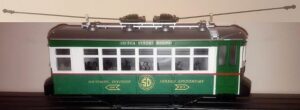
SD TCA 50th Anniversary Pre-Production Trolley
The second of the two non-regular production 50th anniversary trolleys is the Lionel 50th Anniversary Pre-Production Sample Trolley #01. This specific trolley car is the first of the 50 trolleys to be decorated in the Southern Division 50th Anniversary Graphics. Prior to being decorated this car was sent to potential decorators for quotes and then used to try out various alternative graphic designs. Although it has never been run on a track, due to circumstances resulting from the death of our initially contracted decorator, Seymour Knight, this car was very well-traveled having been shipped from New Jersey to Pennsylvania to Florida back to New Jersey then to Michigan and back to New Jersey then back to Florida for approval and finally back to New Jersey for decoration with the final approved graphics design. That car has more frequent flyer miles than most airline passengers! As a result of all of the travel the Lionel box shows considerable wear and tear from the car having been removed and reinserted back into the box so many times. The car closely resembles the final production 50th Anniversary green trolley plus it has all of the same features as the regular production trolley as shown and described elsewhere in this article. However, it also shows some residue from removed test graphics. For those reasons the Committee decided that it was not suitable to sell this car as a regular-production trolley. Instead this car was offered as one of three SD Souvenir Cars being raffled at the 50th Anniversary Party described above.

